flat tire BUICK ROADMASTER 1993 Owners Manual
[x] Cancel search | Manufacturer: BUICK, Model Year: 1993, Model line: ROADMASTER, Model: BUICK ROADMASTER 1993Pages: 340, PDF Size: 18.34 MB
Page 200 of 340
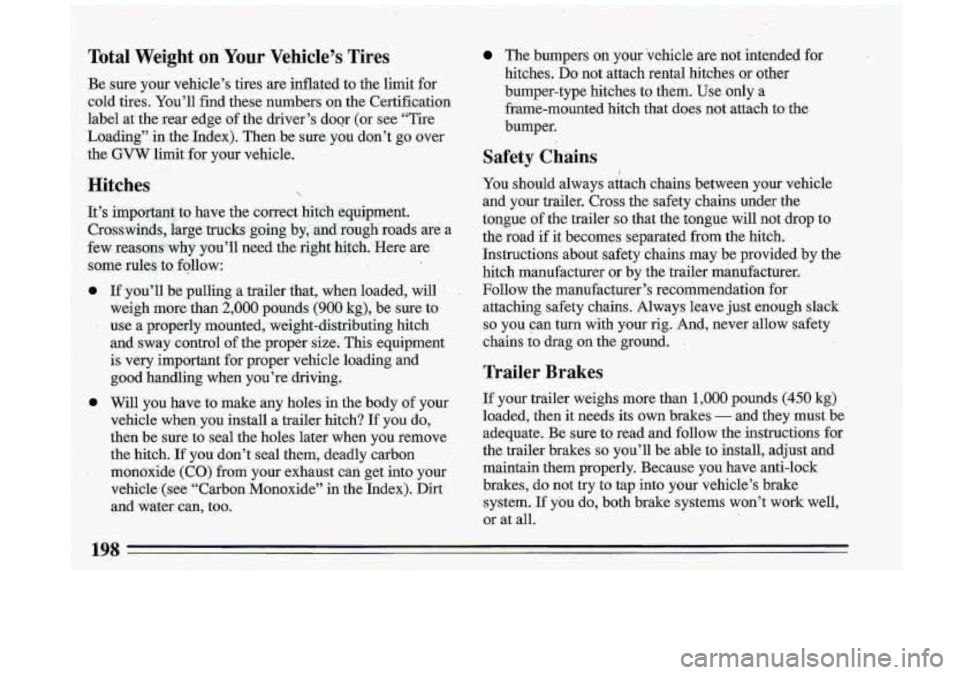
Total Weight on Your Vehicle’s Tires
Be sure your vehicle’s tires are inflated to the limit for
cold tires. You’ll find these numbers on the Certification
label at the rear edge
of the driver’s doqr (or see “Tire
Loading” in the Index). Then be sure you don’t go over
the
GVW limit for your vehicle.
Hitches
It’s important to have the correct hitch equipment.
Crosswinds, large trucks going by, and rough roads are
a
few reasons why you’ll need the right hitch. Here are
some rules to follow:
0
0
If you’ll be pulling a trailer that, when loaded, will
weigh more than
2,000 pounds (900 kg), be sure to
use a properly mounted, weight-distributing hitch
and sway control of the proper size. This equipment
is very important for proper vehicle loading and
good handling when you’re driving.
Will you have to make any holes in the body of your
vehicle when you install
a trailer hitch? If you do,
then be sure to seal the holes later when you remove
the hitch. If you don’t seal them, deadly carbon
monoxide (CO) from your exhaust can get into your
vehicle (see “Carbon Monoxide” in the Index). Dirt
and water can, too.
The bumpers on your vehicle are not intended for
hitches.
Do not attach rental hitches or other
bumper-type hitches to them. Use only a
frame-mounted hitch that does not attach to the
bumper.
Safety Chains
You should always attach chains between your vehicle
and your trailer. Cross the safety chains under the
tongue of the trailer
so that the tongue will not drop to
the road
if it becomes separated from the hitch.
Instructions about safety chains may be provided by the
hitch manufacturer or by the trailer manufacturer.
Follow the manufacturer’s recommendation for
attaching safety chains. Always leave just enough slack
so you can turn with your rig. And, never allow safety
chains
to drag on the ground.
Trailer Brakes
If your trailer weighs more than 1,000 pounds (450 kg)
loaded, then it needs its own brakes
- and they must be
adequate. Be sure to read and follow the instructions for
the trailer brakes
so you’ll be able to install, adjust and
maintain them properly. Because you have anti-lock
brakes, do not try to tap into your vehicle’s brake
system.
If you do, both brake systems won’t work well,
or at all.
198
Page 205 of 340
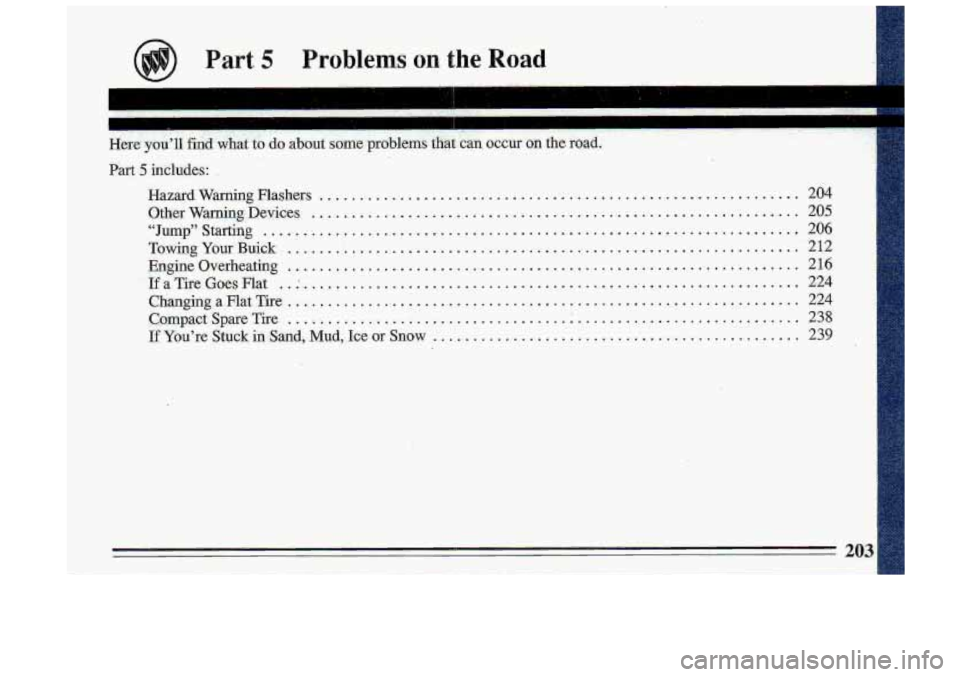
Part 5 Problems on the Road
I- .. . 1. ’ . ’ ‘I
.. .....
Here you’ll find what to do about some problems that can occur on the road .
Part 5 includes:
Hazard Warning Flashers
............................................................
“Jump”Starting ...................................................................
OtherWarningDevices .............................................................
TowingYourBuick ................................................................
Engineoverheating ................................................................
IfaTireGoesFlat .................................................................
ChangingaFlatTire ................................................................
CompactSpareTire ................................................................
If You’re Stuck in Sand, Mud, Ice or Snow ..............................................
204
205
206
212
216
224
224
238
239
Page 226 of 340
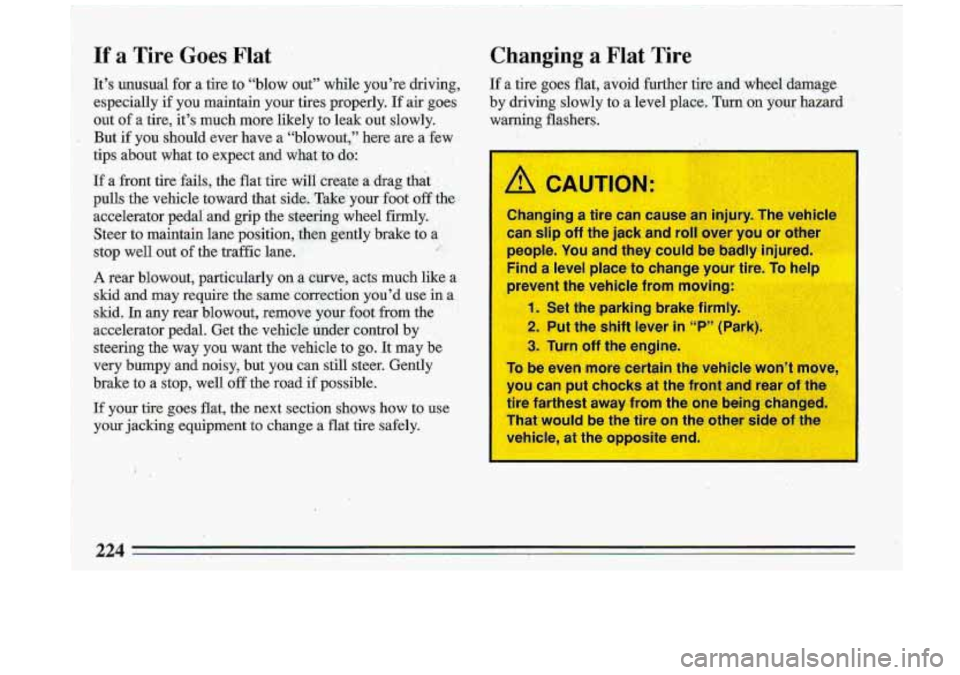
If a Tire Goes Flat Changing .a Flat Tire
I! CAUTIO1
can slip off the jack and roll over you or othe-
people. You and they could be badly injured.
Find a level place to change your
=
prevent the vehicle from moving:
1. Set the parking brake firmly.
2. Put the shift lever in
3. Turn off the engine. Park),
To be even
more certain the vehicle won't move.
you can put chocks at the front and rear of the
tire farthest away from the one being changed.
That would be the tire on the other side
of the
vehicle. at the otmosite end.
Page 234 of 340
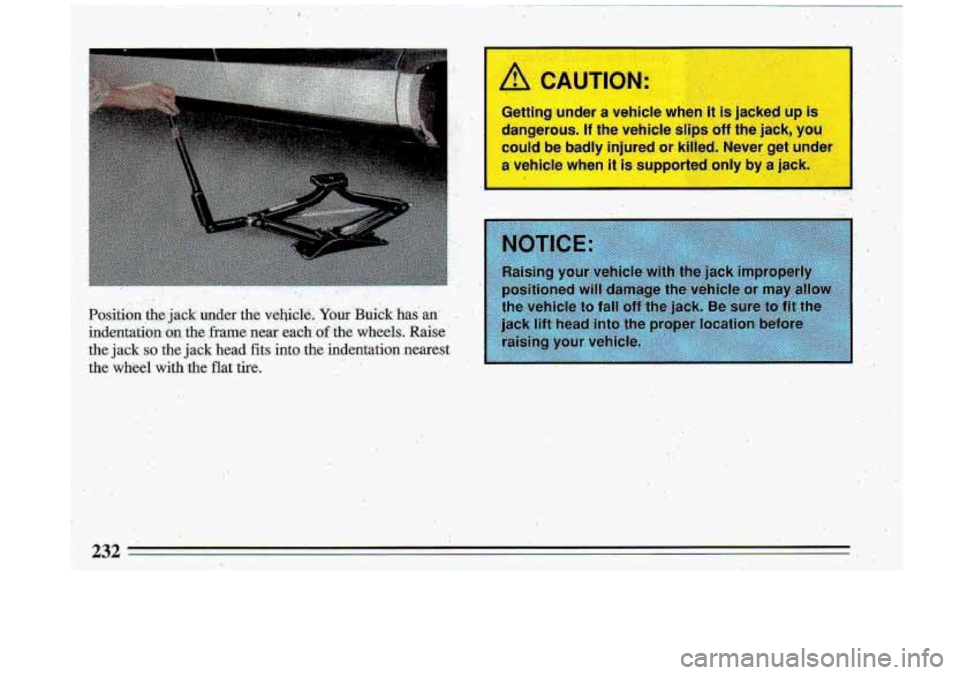
I 'P J 'IC
Getting UI er a vehicle when i s j; ied up is
dangerous. If the vehicle slips off the jack, you
could be badly injured or kilied. Never get wnder
a hide wh I it. orted only by a jack.
Position theijack under the vekcle. ,Your .Buick,has:.m' '.
indentat&n,on the .fi-ame near each 'of the wheels. Raise ' '
the jack so the,jack head fits into-the indentation nearest
the wheel with the flat tire.
232
Page 237 of 340
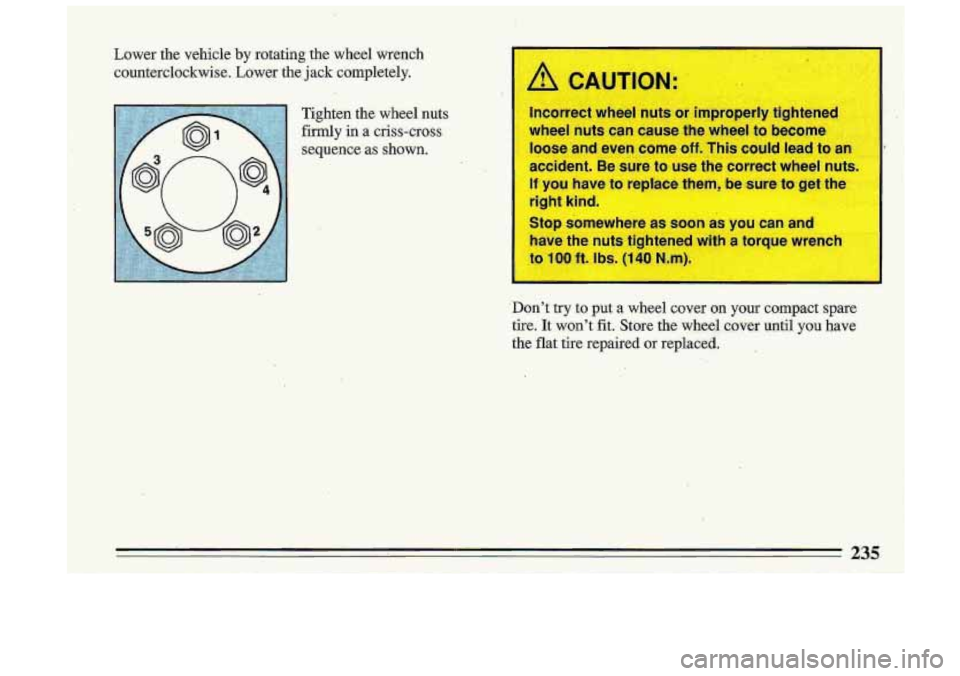
t
Lower the vehicle by rotating the wheel wrench
counterclockwise. Lower the jack completely.
Tighten the wheel nuts
firmly in a criss-cross
sequence as shown.
lncorrect wheel nuts or improperly tightened
wheel nuts can cause the wheel to become
loose and even come
off. This could lead to an
accident. Be sure to use the correct wheel nuts.
If you have to replace them, be sure to get the
right kind.
Stop somewhere
as soon as you can an
have the nuts tightened with
a
to I00 ft. Ibs. (1 40 N.m)
Don't try to put a wheel cover on your compact spare
tire. It won't fit. Store the wheel cover until
you have
the flat tire repaired or replaced.
. .. .i ,?. 1 C.".
235
Page 240 of 340
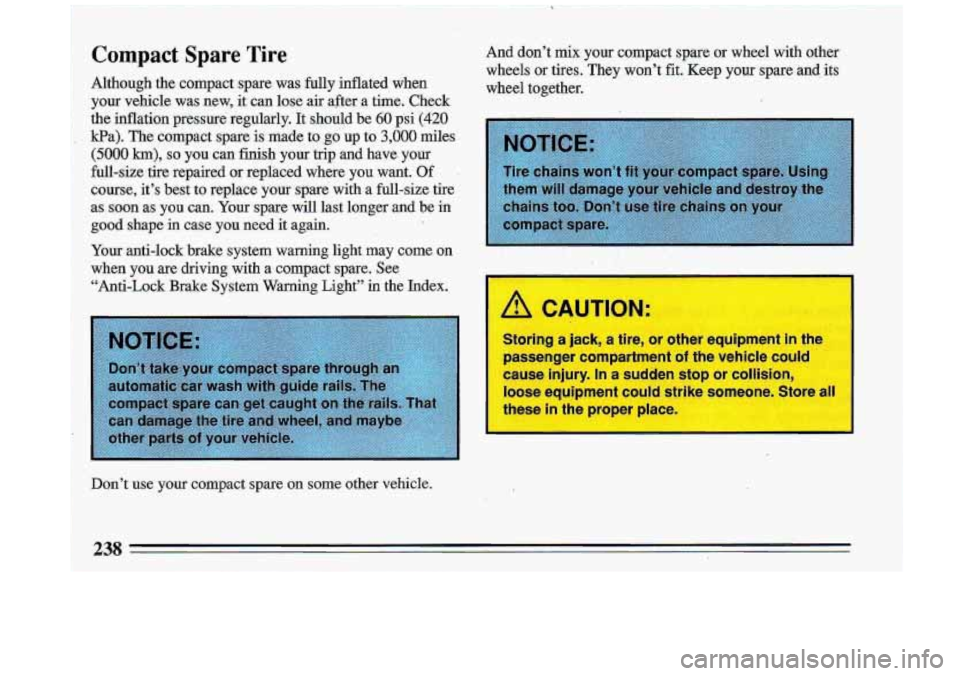
Compact Spare T,ire
Although the compact spare was fully inflated when
your vehicle -was new, it can lose air after a time. Check
the inflation pressure regularly. It should be
60 psi (420
Pa). The compact spare is made to g6 up to 3,000 miles
(50,OO km), so you can finish your trip and have. your
full-size tire repaired
or replaced where you want. Of
course, it’s best to replace your spare with a full-size ti\
re
as soon as you can. Your spare will last longer and be in
good shape in case you need it again.
Your anti-1ock.brake system warning light -may come on
when you are driving with a compact spare. See
“Anti-Lock Brake System Waming Light”
in the Index.
Don’t-use
your compact spare on some other vehicle. And don’t mix your compact spare or wheel
with other
wheels or tires. They. won’t
fit.. Keep your spare and its
wheel together.
., ,. .. .. , ...
L CAUTIOF
s J a Jal , a we, or orner equlpmenr in rn
passenger compartment of the vehicle could
cause injury. In
a sudden stop or collision,
loose equipment could strike someone. Store al
these
in the proper place
3s
Page 271 of 340
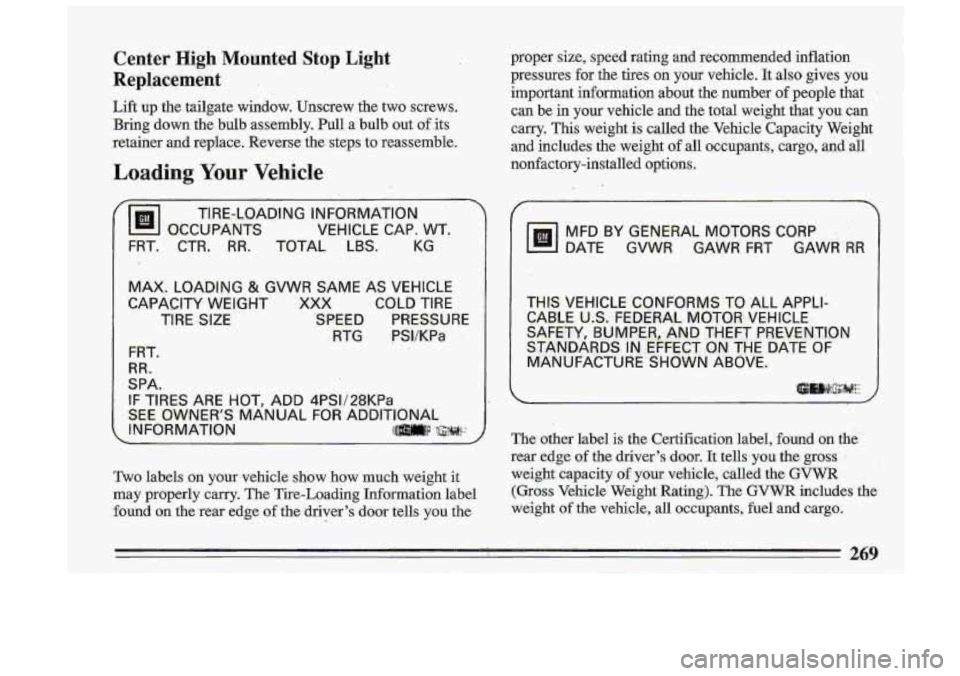
Center High Mounted Stop Light
Replacement
Lift up the tailgate window. Unscrew the two screws. Bring down the bulb assembly. Pull a bulb out of.its
retainer and replace. Reverse the,steps to reassemble.
Loading Your Vehi.cIe
proper size, speed rating and recommended inflation
pressures for the tires
on your vehicle. It also gives you
important information about the number
of people that
can be in your vehicle and the total weight that you can
carry.
This weight is called the Vehicle Capacity Weight
and includes the weight of
all occupants, cargo, and all
nonfactory-installed options.
@I OCCUPAN'TS TIRE-LOADING
INF0,RMATlON
.
V:EHICLE CAP, WT.
FRT.. CTR. RR. TOTAL LBS. KG
1
MAX. LOADING & GVWR SAME AS VEHICLE
CAPACITY
WEIGHT XXX COLD TIRE
TIRE SIZE
SPEED PRESSURE
.RTG PSI/KPa
FRT.
RR.
SPA.
IF TIRES ARE HOT, ADD 4PSI/28KPa
SEE OWNER'S 'MANUAL FOR ADDITIONAL
INF0,RMATlON
ll]mp ,$$$#/:::
Two labels on your vehicle show how much weight it
may properly carry. The Tire-Loading Information label
found -on- the rear edge of the driver's door tells you the
Y
MFD BY GENER-At MOTORS CORP
DATE GVWR GAWR FRT GAWR
RR
THIS VEHICLE CONFORMS TO 'ALL APPLI- CABLE US. FE,DE.RAL MOT0.R'
VEH'ICLE
SAFETY, BU.MPER,-AND THiEFT PREVENTI0.N
STANDARD,S IN EFFECT ON THE DATE
OF
MANUFACTURE SHOWN ABOVE.
~i~,l\i$;~!~~!~
The other label is the Certification 'label, found on the'
rear edge of the driver's do,ar. It tells you the gross
weight capacity
of your vehicle, called the GVWR
(Gross Vehicle' Weight Rating). The GVWX includes the.
weight of the vehicle, all occupants, fuel and cargo.
269
Page 274 of 340
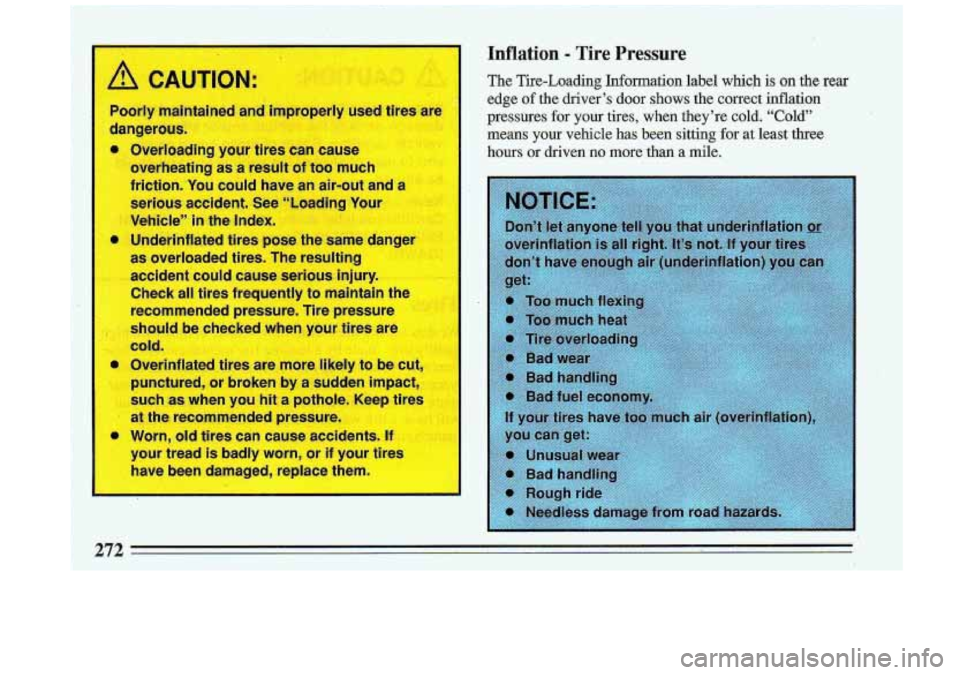
ION
)orly maintained and improper1
dangerous.
Overloading
- 3ur tires can caus [sed
tires are
e
overheating as a result
of too much
friction:You could have an air-out ant
serisws accident. See -“Loading Your
Vehicle”
in the Inde:
Underinflated tires
pose the same dangc
as overloaded tires. The resulting
accident’could cause serious injury.
Check
all tires frequently to maintain a I
recommended pressure. Tire pressure
sha I be checked when your tires are
cold
Overinflated tires are more likely to be cut,
punctured, or broken
by a sudden impact,
such as when
you hit a pothole. Keep tires
at the recommended pressure
Worn, old tires can cause accidents.
I,
your tread is badly worn, or if your tires
have been damaged, replace them.
Inflation - Tire Pressure
The Tire-Loading Information label which is on the rear
edge of the driver’s door shows the correct inflation
pressures
for your tires, when they’re cold. “Cold”
means your vehicle
has been sitting for at least three
hours or driven no more than a mile.
Page 275 of 340
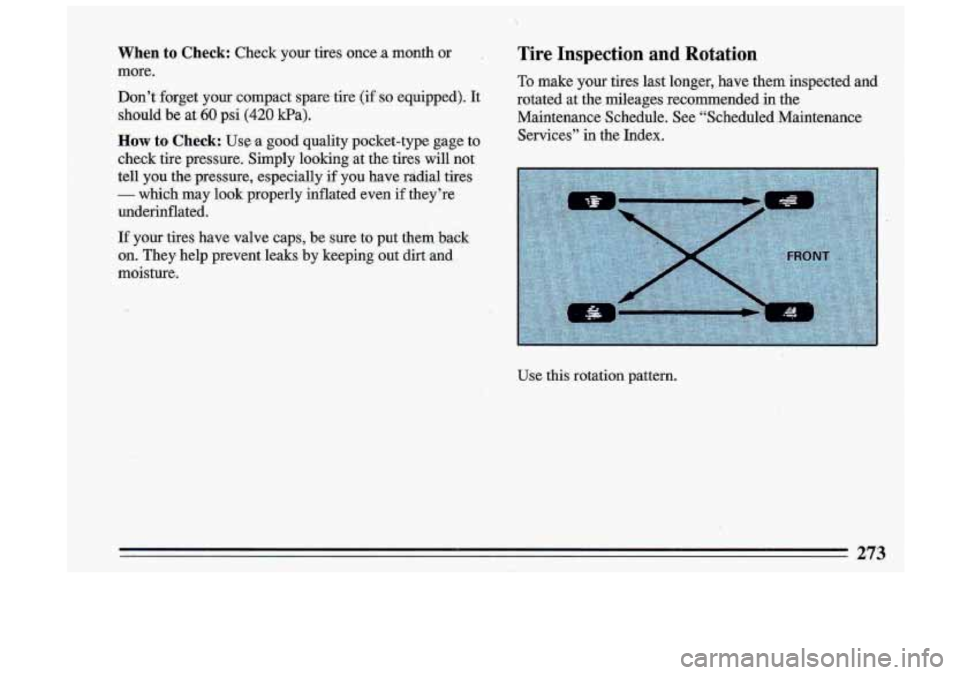
When to Check: Check your tires once .a month or
more.
Don’t forget
your compact spare-tire (if SO equipped). It
should be at 60 psi (420 Pa).
How to Check: Use a good quality pocket-type gage to
check tire pressure. Simply looking at the tires will not
tell you the pressure, especially if
you have radial tires
- which may look properly inflated even if they’re
underinflated.
If your tires have valve caps, be sure to put them back
.on. They help prevent leaks by keeping
out dirt and
moisture.
Tire Inspection and Rotation
To make your tires last longer, have them inspected and
rotated at the mileages recommended in the, Maintenance Schedule. See “Scheduled Maintenance Services”
in the Index.
Use this rotation pattern.
t
273
Page 276 of 340
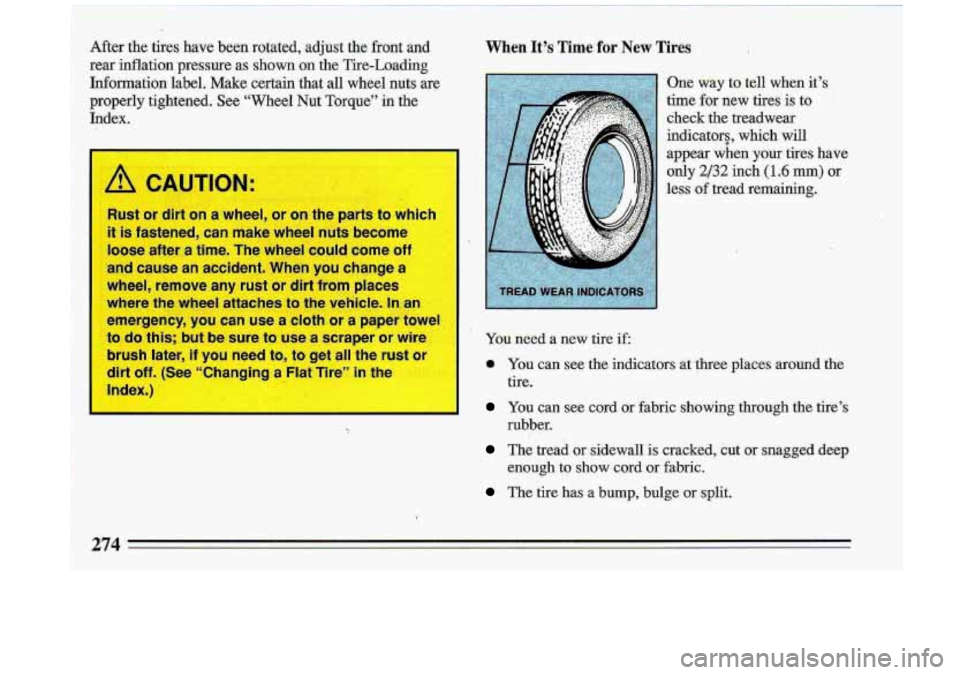
After the tires have beers rotated, adjust the front and
rea inflation pressure as shown on the Tire-Loading
Information label. Make certain that all wheel nuts ax9
properly tightened. See “Wheel Nut Torque” in the
’ ..
Index.
A CAUTION:
Rust or diir on a wheel, or on the parts to which
it is fastened, can make wheel nuts become
loose after a time. The wheel-could come off
‘and cause an accident. When you change a
wheel, remove any rust or dirt from places
where the wheel attaches to the vehicle.
In an
emergency, you can use a’cloth or a paper towel
to
do this; but be sure to use a scraper or wire
brush later,
if you need to, to get all the rust --
dirt off. (See “Changing a Flat Tire” in the
Index.)
I
When It’s Time for New Tires
One way to tell when it’s
time for new tires
is to.
check the treadwear’-
*. ’
indicators, which will
appear when your tires have only
2/32 inch (1.6 mm) or
less of tread remaining.
I
I
.’
DU need a new tire if
You can see the indicators at three places around the
tire.
You can see cord or fabric showing through the tire’s
The tread or sidewall is cracked, cut -or snagged deep
rubber.
enough to show cord or fabric.
The tire has a bump, bulge or .split.
274